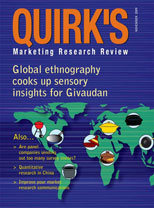Editor’s note: Joel Zeiler is senior vice president at Ipsos Marketing, a Westbury, N.Y., research firm. This article appeared in the November 9, 2009, edition of Quirk's e-newsletter.
Litigation cases involving claims of false advertising brought under the government's Lanham Act are frequently won or lost based on the quality of the supporting marketing research, and that research’s ability to persuade the court that its design and analytics are credible.
The basic tenet of advertising law is that advertising must be truthful and in no way deceptive. As an advertiser, you can knowingly or unknowingly break this rule through either your misrepresentation or omission of facts that make what is stated misleading.
These concepts apply to the advertisement as a whole and to specific claims made therein. And the tenet is not only for claims about your products or services but for claims made about a competitor’s products or services as well. Further, while comparative advertising is allowable, and even encouraged, like all other advertising, it too must be truthful.
So, when you’re considering a claim about your product or service, or those of your competitor’s, be prepared to back up what you say.
There are generally three main regulatory avenues for addressing false advertising claims:
• The Federal Trade Commission (FTC) is empowered to outlaw unfair or deceptive trade practices. It can investigate (with broad subpoena power) industry practices or actions of a single company, issue cease-and-desist orders and seek a variety of court-imposed civil and criminal sanctions. The publicity alone from an FTC investigation and/or cease-and-desist order can be devastating to any business.
• The National Advertising Division (NAD) of the National Council of Better Business Bureaus is a self-regulating outlet for advertisers. The NAD receives or initiates, evaluates, investigates, analyzes and decides claims of false or misleading advertising, usually within a 90-day period. While voluntary, the vast majority of advertisers participate in NAD proceedings and abide with the NAD’s decisions. The NAD works closely with the FTC and can refer cases of advertisers who do not comply with its decisions.
• The Lanham Act governs federal trademark law and provides for private enforcement action based on any false or misleading description or representation of fact made about the advertiser’s own products or services or a competitor’s.
Lanham Act false-advertising claims require proof of four elements:
1. A false or misleading description or representation of fact made in interstate commerce in connection with any goods or services …
2. … that actually deceives, or is likely to deceive, a substantial segment of the intended audience …
3. … that is material (likely to influence purchase decisions) and …
4. … that results, or is likely to result, in injury to the plaintiff.
Should the need arise, here are some guidelines to get the most out of your litigation research:
1. Commission the research early, as some litigation surveys take from one to several months to complete, depending on their size and complexity. Commissioning the research early can allow for a pilot survey (a small-scale version of the research) to assist in making a go/no-go decision on the complete survey. Choosing not to proceed with a particular survey in its entirety leaves you time to modify the pilot survey or to turn to a second researcher to conduct a different survey.
2. Evaluate the survey as if you were the other side. No survey is perfect. Ask your expert what areas of the research are most likely to be attacked by the opposition, including sample design, question wording, fieldwork, validation, etc. A good litigation researcher is likely to know the area in his/her survey most vulnerable to attack.
3. Be sure to at least consider using a control cell. Most often, the objective of the research is to measure the effect that an advertising message, product feature or other variable has on the perceptions or behavior of a particular population. By comparing the results of the test cell to those of the control cell, you can isolate the effect(s) that owe solely to the offending message or claim.
4. Don’t expect your researcher to be an advocate. A good litigation researcher must remain objective and offer you a design that could be used by either the plaintiff or the defendant.
